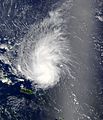Tropical wave facts for kids
Tropical waves are like long, wavy areas of lower air pressure. They stretch from north to south and move from east to west across warm parts of the Earth. These waves bring clouds and thunderstorms with them. In the Atlantic Ocean, they are often called African easterly waves because they start near Africa.
These waves form where winds blow from the east, near a high-pressure area. This is close to the equator, in a zone called the Intertropical Convergence Zone (ITCZ). Tropical waves are carried westward by the strong easterly winds. They can sometimes grow into powerful storms like tropical cyclones, which can then become hurricanes, especially in the North Atlantic and Northeast Pacific Oceans.
Contents
What are Tropical Waves Like?
Before a tropical wave arrives, the air is often dry and sinking. The wind usually blows from the northeast. As the middle of the wave passes, the wind changes to the southeast. The air suddenly becomes much more humid, and the atmosphere gets unstable. This causes widespread showers and thunderstorms, which can sometimes be strong. As the wave moves further west, the rain slowly stops.
Sometimes, especially in the Atlantic, a large amount of very dry air called the Saharan Air Layer (SAL) can follow a tropical wave. When this happens, the sky might be clear or have very few clouds. This dry air can stop thunderstorms from forming. Also, any dust in the SAL can reflect sunlight, making the air below it a little cooler.
Tropical Waves in the Atlantic
Tropical waves in the Atlantic Ocean start as disturbances that move off the coast of Africa. Strong easterly winds, called the African Easterly Jet, help these waves form and grow. A large area of high pressure, centered near the Azores islands, helps push these waves away from Africa towards North America.
A lot of Atlantic tropical cyclones (about 60%) first form from these tropical waves. Even more, about 85% of the strongest Atlantic hurricanes (Category 3 and higher on the Saffir–Simpson Hurricane Scale) begin as tropical waves.
Sometimes, a tropical cyclone can weaken and turn back into a tropical wave. This usually happens if the winds high up in the atmosphere are too strong. However, the storm can grow strong again if these winds calm down. A fast-moving tropical wave can have very strong winds, but it's only called a tropical storm if it has a closed circulation, meaning the winds are circling around a center.
Tropical Waves in the East Pacific
Scientists think that tropical cyclones in the eastern Pacific Ocean also form from tropical waves that come from North Africa. During the summer, these tropical waves can travel north all the way to the desert southwest of the United States. When they do, they can bring periods of heavier rain to areas that are already experiencing the monsoon season.
Related pages
Images for kids
-
2013's Tropical Storm Dorian as a tropical wave on July 29
See also
 In Spanish: Onda tropical para niños
In Spanish: Onda tropical para niños


